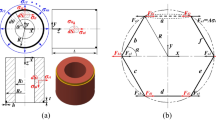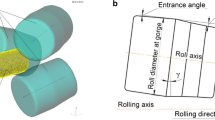Abstract
According to the distribution characteristics of equivalent plastic strain (PEEQ) in radial–axial ring rolling, the plastic deformation zones in cross section were established. A 3D rigid-viscoplastic finite element model (FEM) which was controlled adaptively was applied to investigate defects that occurred during ring rolling under ABAQUS software. PEEQ, stress, and temperature distributions in different deformation zones have been analyzed in this study. Strain peaks were found in the cross-section corners. Moreover, it was investigated that non-uniform strain, stress, and temperature distributions in the ring tend to cause non-uniform microstructure and properties. Therefore, forming defects and microstructure damage would appear in cross-section corners due to the high-strain deformation. Based on the new developed FEM of the radial–axial ring-rolling process and comprehensive numerical simulations, the size effects of feed rate and lubrication conditions on strain and temperature distributions and their uniformity were investigated by 3D coupled thermomechanical FE simulation. The results have good agreement with experiment. The achievements of this study can provide basis for quality control and technical guidance.
Similar content being viewed by others
References
Ma Q, Lin ZQ, Yu ZQ (2009) Prediction of deformation behavior and microstructure evolution in heavy forging by FEM. Int J Adv Manuf Technol 40:253–260
Joun MS, Chung JH, Shivpuri R (1998) An axisymmetric forging approach to preform design in ring rolling using a rigid–viscoplastic finite element method. Int J Mach Tools Manuf 38:1183–1191
Kim NS, Machida S, Kobayashi S (1990) Ring rolling process simulation by the three dimensional finite element method. Int J Mach Tools Manuf 30:569–577
Wang M, Yang H, Sun ZC, Guo LG, Ou XZ (2006) Dynamic explicit FE modeling of hot ring rolling process[J]. Trans Nonferrous Met Soc China 6(6):1274–1280
Davey K, Ward MJ (2003) An ALE approach for finite element ring-rolling simulation of profiled rings. J Mater Process Technol 139:559–566
Alfozan A, Gunasekera JS (2002) Design of profile ring rolling by backward simulation using upper bound element technique (UBET). J Manuf Process 4:97–108
Xie C, Dong X, Li S, Huang S (2000) Rigid–viscoplastic dynamic explicit FEA of the ring rolling process. Int J Mach Tools Manuf 40:81–93
Yea YS, Ko YS, Kim NS, Lee JC (2003) Prediction of spread, pressure distribution and roll force in ring rolling process using rigid-plastic finite element method. J Mater Process Technol 140:478–486
Koo SW, Lee JC, Yoon SJ, Kim NS (2003) Analysis of aluminum ring rolling process using thermo-rigid-plastic finite element method. Transactions of the Korean Society of Mechanical Engineers 27:815–822
Forouzan MR, Salimi M, Gadala MS (2003) Three-dimensional FE analysis of ring rolling by employing thermal spokes method. Int J Mech Sci 45:1975–1998
Moon HK, Lee MC, Joun MS (2008) Predicting polygonal-shaped defects during hot ring rolling using a rigid-viscoplastic finite element method. Int J Mech Sci 50:306–314
Xu SG, Cao QX (1994) Numerical simulation of the microstructure in the ring rolling of hot steel. J Mater Process Technol 43:221–235
Qian DS, Hua L, Zuo ZJ (2007) Investigation of distribution of plastic zone in the process of plastic penetration. J Mater Process Tech 187:734–737
Forouzan MR, Salimi M, Gadala MS, Aljawi AA (2003) Guide roll simulation in FE analysis of ring rolling. J Mater Process Technol 142:213–223
Li LY, Yang H, Guo LG, Sun ZC (2008) A control method of guide rolls in 3D-FE simulation of ring rolling. J Mater Process Technol 205:99–110
Zenter C, Hollomon H (1994) Effects of strain rate upon plastic flow of steel [J]. J Appl Phys 15:22–32
Gearing BP, Moon HS, Anand L (2001) A plasticity model for interface friction:application to sheet metal forming. Int J Plast 17:237–271
Author information
Authors and Affiliations
Corresponding author
Rights and permissions
About this article
Cite this article
Zhou, J., Wang, Fl., Wang, Mh. et al. Study on forming defects in the rolling process of large aluminum alloy ring via adaptive controlled simulation. Int J Adv Manuf Technol 55, 95–106 (2011). https://doi.org/10.1007/s00170-010-3023-6
Received:
Accepted:
Published:
Issue Date:
DOI: https://doi.org/10.1007/s00170-010-3023-6




